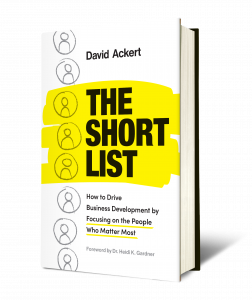While strained marketing and business development teams increase their investments in technologies to help them attract, target, and acquire new business, firms still need their seller-doers, like lawyers, accountants, financial advisors, engineers, consultants, to do the thing they resist most: selling.
Addressing the disconnect between the business development team’s (and the firm’s) strategic goals and the seller-doers’ desires requires a culture change that can be difficult to achieve without external resources. That’s why more than 70% of U.S. firms adopt business development training and coaching programs.
Why combine business development training and coaching? The distinction between the two is simple: Training is an educational process that teaches new information, best practices, and techniques – a one-way flow of information typically delivered through lectures, e-learning, or written materials; Coaching is an interactive process that encourages participants to explore new ideas, air out concerns, and practice techniques to be better prepared to succeed when it comes time to apply what they’ve learned.
Together, they become a powerful combination for teaching the nuanced soft skills and discipline required to develop and expand a sophisticated, sustainable client base. For the purposes of this guide, let’s focus on coaching.
Following are time-tested tips for creating and implementing a business development coaching program at your firm.
1. Obtain Buy-In
Of course, you’ll need to “sell” your idea first. If your product is a business development coaching program and your prospects are busy service professionals, you won’t be able to close them if you don’t address their objections. Be prepared to address the most common:
- “I don’t have time.”
- “I have enough work on my plate. I don’t need more.”
- “I don’t know where to start.”
- “I think selling is sleazy.”
2. Select Motivated Candidates
Participant selection is one of the primary driving factors of success in any business development coaching initiative. Invest in professionals who have shown an appetite for business development by positioning the program as a privilege. Initiate the selection process with an application process that examines potential coachees’ motivations for wanting to join the program and what they intend to achieve.
3. Use Time-efficient Materials
Even the most enthusiastic professionals will balk if training materials require too significant a time investment. Assemble a curriculum that requires a manageable amount of non-billable time. On-demand training materials delivered via mobile app can be particularly effective.
4. Prompt Action with Triggers
For a desired behavior to occur, a certain level of motivation, ability, and a trigger, must occur simultaneously. When someone has high motivation and a task that’s easy to do, a trigger will prompt the desired behavior. The lower the motivation level, the easier the task must be to prompt action. Try using email newsletters, push notifications, coaching sessions, in-person office visits, gamification scoreboards, and other creative solutions. To maximize bandwidth, automate triggers using sales acceleration tools like PIPELINEPLUS.
5. Get a Leg Up with a Well-planned Kickoff Session
Begin your coaching initiative with a group lunch-and-learn to set expectations for the program’s structure. Firm leadership should deliver a strong opening message to set the tone of the initiative, letting participants know that the program will require an investment of time and effort and that success is wholly dependent on the participants. Let them know that there is a waitlist, and anyone who does not commit meaningfully may forfeit their seat, so that it can be filled by someone dedicated to the program.
Also, ask participants to evaluate their current business development abilities with a self-assessment survey. The self-assessment survey can also include questions that identify participants’ strengths and goals. This will help them spend their limited time strategically.
Finally, set up expectations on how ROI will be measured. Ask the participants to complete a questionnaire that names a performance baseline. Measure proactive behaviors, like touchpoints per week or pitch meetings per month rather than reactive indicators like RFPs received.
6. Choose Curriculum Wisely
The content of a coaching program should be as convenient as possible. Consider online materials rather than classroom-style teaching, and opt for on-demand videos or webinars, online reading material, and other content that participants can consume at their own pace.
Survey participants in advance to find out the types of content they want to learn about. Focus on topics relevant to participants’ roles. For example, topics for associates/managers may include establishing credibility, broadening your network, and presentation skills. In contrast, topics for partners may include developing client listening/opportunity-spotting skills, honing pitching skills, and mining opportunities for existing clients and networks. Tailor strategies to individuals’ strengths.
7. Put Accountability Structures in Place
Regular coaching sessions are an effective way to ensure accountability and keep high engagement. A group coaching model tends to work well for younger professionals, while individual coaching works best for those more comfortable with sales, as they benefit most from coaching around nurturing specific relationships.
If you don’t have a team member who can challenge participants, don’t launch a program that requires them to change behavior because it will fizzle. Instead, consider upgrading your team’s coaching abilities by engaging an external coach or enrolling them in a train-the-trainer program geared toward professional services marketers.
Work with leadership to create accountability measures like rewards for excellence and repercussions for non-participation.
8. Track Results and ROI
Many professional services marketers would rather help shape firm strategy than be nudgers and project managers. But it’s challenging to do because most marketing and business development teams don’t directly generate revenue.
Also, many marketers struggle to draw even an indirect line between their efforts and new business development revenue. Without this proof-of-concept or justification of one’s budget, many partners simply don’t appreciate the value that marketing and business development team members bring to the table.
To create a “seat at the table,” convert data into actionable intelligence by aggregating and analyzing key business metrics.
Tracking metrics equips marketers with the ability to:
- Discover inefficiencies, wasteful expenditures, under-performing participants, or unprofitable clients
- Find which marketing and business development initiatives generate the greatest ROI
- Enable new revenue by identifying leads and cross-selling opportunities
- Improve pricing models by tracking AFAs, discounts, and realization
- Demonstrate that the marketing or business development department is a profit center rather than a cost center
PIPELINEPLUS includes customized business intelligence dashboards that capture data and point to the business outcomes directly linked to marketing and business development departments.
9. Outsource Elements of a Coaching Program
Effectively outsourcing your coaching program can significantly reduce the burden on your department’s bandwidth, leverage service providers’ strengths, and generate a higher ROI than if you were to do it all in-house.
If you don’t have the bandwidth or expertise to develop your own curriculum, consider outsourcing this part of your initiative. PIPELINEPLUS features online training through an in-app library of micro lessons, a relationship tracking tool, AI-powered suggestions on how to close deals, and 150+ specific action steps that create proven growth.
10. Outsource Your Complete Coaching Program
An effective program requires time, talent, resources, and credibility among coaching participants. Engaging with an external resource with a proven track record and credentialed, specialized coaches can save you time and resources, and also be significantly more effective.
Ackert’s sales and business development coaching and training programs are designed specifically for professional services firms. Seller-doers and business developers receive coaching on an array of topics that guide them in developing and nurturing relationships with prospects, clients, and referral sources through every stage of the sales pipeline. The professional growth participants experience, in turn, contributes to the growth of your firm.
For more details on the topics above, read the blog post “A Complete Guide to Implementing a Successful Business Development Coaching Initiative” and “Internal vs. External Business Development Training: What Can We Take On? What Should We Outsource?”







